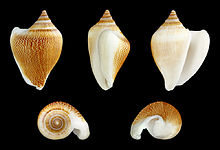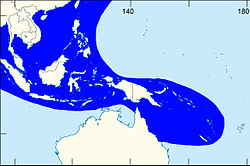Laevistrombus canarium
| Laevistrombus canarium | |
|---|---|
 |
|
| Five different views of a shell of an adult L. canarium: abapertural (upper left), right lateral (center), apertural (upper right), apical (lower left) and basal (lower right) | |
| Scientific classification | |
| Kingdom: | Animalia |
| Phylum: | Mollusca |
| Class: | Gastropoda |
| (unranked): | clade Caenogastropoda clade Hypsogastropoda clade Littorinimorpha |
| Superfamily: | Stromboidea |
| Family: | Strombidae |
| Genus: | Laevistrombus |
| Species: | L. canarium |
| Binomial name | |
|
Laevistrombus canarium (Linnaeus, 1758) |
|
 |
|
| The shaded area indicates the distribution of Laevistrombus canarium within the Western Central Pacific, according to Poutiers, 1998. | |
| Synonyms | |
|
|
| External identifiers for Laevistrombus canarium | |
|---|---|
| WoRMS | 564722 |
Laevistrombus canarium (commonly known as the dog conch or by its better-known synonym, Strombus canarium) is a species of edible sea snail, a marine gastropod mollusc in the family Strombidae (true conches). Known from illustrations in books dating from the late 17th century, L. canarium is an Indo-Pacific species occurring from India and Sri Lanka to Melanesia, Australia and southern Japan. The shell of adult individuals is coloured from light yellowish-brown to golden to grey. It has a characteristic inflated body whorl, a flared, thick outer lip and a shallow stromboid notch. The shell is valued as an ornament, and because it is heavy and compact it is also often used as a sinker for fishing nets.
The external anatomy of the soft parts of this species is similar to that of other strombid snails. The animal has an elongate snout, thin eyestalks with well-developed eyes and sensory tentacles, and a narrow, strong foot with a sickle-shaped operculum. A molecular analysis conducted in 2006 based on DNA sequences of histone and genes demonstrated that Laevistrombus canarium, Doxander vittatus and Labiostrombus epidromis are closely related species. The dog conch exhibits behaviours common among Strombidae, including burrowing and a characteristic leaping form of locomotion. The former behaviour, however, involves movement sequences unique to this species.
...
Wikipedia
